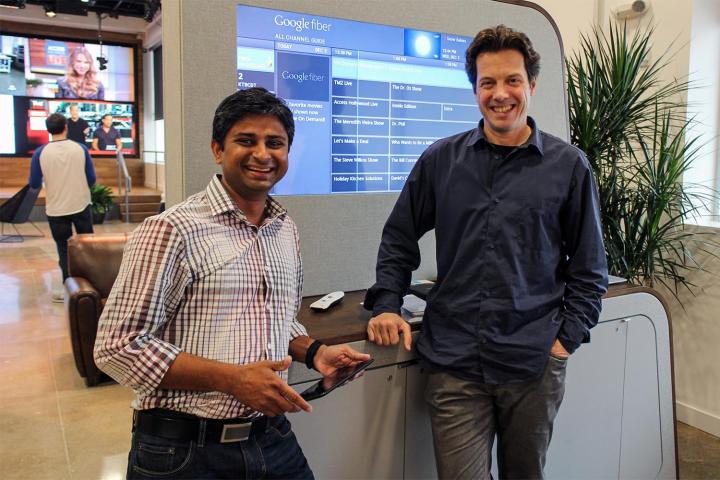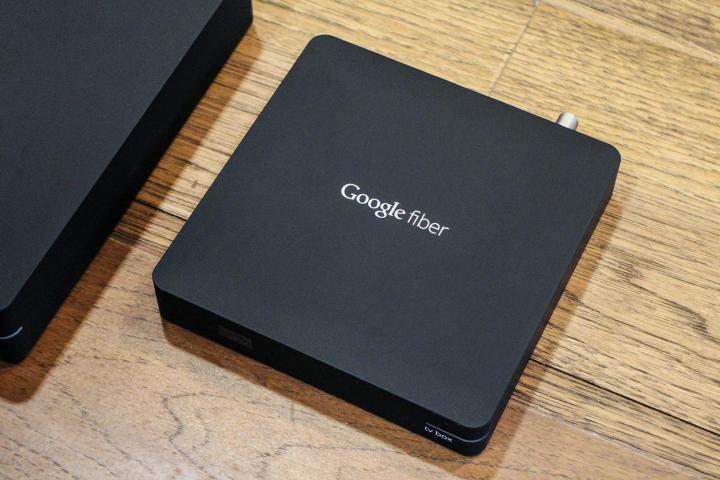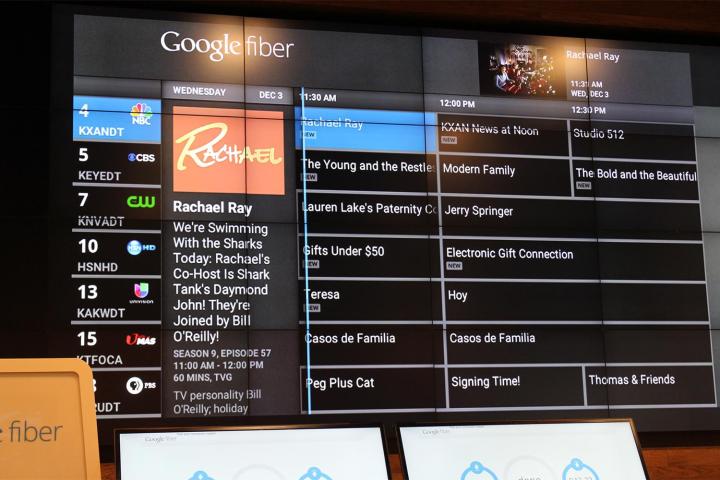
We recently sat down with Google’s Adam Smith and Sarthak Ray in Fiber’s second expansion city, Austin, TX, to find out more about Google’s plans for Fiber, including what we can expect to see from the service in the future, how Fiber can help to revolutionize entertainment and Web technology, and how Google’s “don’t be evil” mentality can help prevent the tech mega-giant from becoming the next Comcast.
Everything about Fiber is different, from Google’s roadmap for deployment to the hardware and services it offers.
Fiber is certainly not the first service to offer 1 Gbps Internet speeds to residential customers. But everything about Fiber feels a little different, from Google’s roadmap for deployment, to the hardware and services it offers. Fiber begins in Austin in just a few neighborhoods, requiring neighbors to rally together and meet sign-up deadlines to get the ground broken for Fiber’s build out, which will then see a blitz of construction to lay the pipes.
“Part of it is, you are really building momentum, right?,” Fiber’s Head of Product Management, Adam Smith tells us. “It helps identify where the demand is, but then it also sort of builds within the community a sense of momentum around what’s there.”
“One of the reasons we do this is to help optimize our construction, too,” Sarthak, who is Fiber’s Product Manager for Devices, adds. “Yes, there’s demand (for Fiber) everywhere, but we can’t go build everywhere at once, so it helps us if we have a mass of people in an area to help make construction both faster and more efficient.”
It’s also important to remember that Google isn’t just flipping a switch here. Through an all out construction blitz, the company is attempting to do a remarkable amount of infrastructure build-up on an extremely tight timeline, digging up the earth, and laying miles and miles of cables to bridge current fiber optic pipelines directly to your abode. That’s why it’s important for Google to be judicious in how it chooses its first so-called “fiberhoods,” allowing it to breath Fiber into existence and spark the fire to get adjoining neighborhoods signed up and committed to choosing Google as their service of choice.

Several South Austin neighborhoods identified by Google as eligible for Fiber have already met their deadline goal, with nearly 100 days left to go. The demand for an alternative to the sort of sluggish, notoriously expensive cable and Internet service from providers like Time Warner Cable is palpable in Austin. And while $70 for 1 Gig, or $130 for 150+ TV channels is certainly enticing, its also the distinctly different feel of a service offered by a revolutionary company like Google that has people chomping at the bit.
“Google, from the very beginning, has focused on its users, and trying to create a good user experiences, and I think a large part of that is how we got into fiber,” Adam says. “We believed that we could provide a superior Gig Internet experience with a television experience. So, we always try to lead with that: try and understand what the users want, and try and deliver that to them.”
“We always try to lead with that: Try and understand what the users want, and try and deliver that to them.”
Sure, that sounds great in theory, but it also sounds a bit like the kind of boilerplate answer you’ll get from competitors like Comcast. So what makes Google different?
“If you look at our history, and you look across our product portfolio, we’ve been successful in really providing open platforms, like Search, Android, etc., and I think that’s really our approach, is that what’s best for users, that’s what’s best for innovation,” Adam says.
“You don’t know where innovation is going to come from, so, removing as many constraints as you can … you are able to really see what’s possible. You can’t predict (innovation), you can’t prescribe it, it has to just sort of grow naturally and emerge.”
As such, Fiber seems to be more of a launching point for what Google sees as the next chapter of the Internet age, just barely scratching the surface of what’s possible. You can catch a glimpse of that from Google’s TV service, which is able to leverage Fiber’s lightning-fast speed to use less compression for a crystal clear image. And because Fiber uses an IP(Internet Protocol)-based delivery method, it is also highly adaptable for the future of TV, including 4K and even 8K UHD resolutions.
- 1. Fiber TV box
- 2. Fiber backlit remote
- 3. Fiber TV search window
- 4. Fiber TV channel guide
“We offer a very high quality TV product, and the quality of the TV stream that we’re able to provide over IP is very high, and is very sharp, and I think we’ve been able to demonstrate that we want to be on the front edge of a quality television and video service,” Adam says.
And though both Adam and Sarthak were mum when asked about future plans for 4K UHD support, Sarthak hinted that Google’s TV service will be ready to drive 4K through its powerful pipes when the resolution has reached its maturity.
“A lot of these content providers are just starting to bring content, they have limited pipes, so they have limited space to expand and we do TV over IP specifically for the flexibility it gives us to use as much or as little compression as we want…to do 4K, and 8K over time. That said, even right now, we have the Gigabit pipe so 4K service from Netflix is going to work better, and it’s going to be a lot smoother.”
“The quality of the TV stream that we’re able to provide over IP is very high, and is very sharp.”
Another example of Fiber’s sharp focus on innovation, and a better experience for the end user, is the fact that its latest products, the Network+ box, and the new TV box, are specifically designed to push the boundaries of what’s possible with Wi-Fi, which is still unable to reach the Gigabit speeds possible from a wired connection. In the bustling Fiber demo room loaded with connected devices in Austin, Fiber over Wi-Fi topped out at around 500 Mbps download, and 200 Mbps up.
“It’s wonderful to have the lights coming into your wall, but 70 percent of devices connect via Wi-Fi and it’s growing,” Adam said. “So you look at that (and realize) if you’re going to provide a great service to users, you have to be focused on that part of it … so everyday we go to head engineers here to improve the core product, just trying to work through the process of how we can provide higher bandwidth over Wi-Fi throughout your entire home.”
Google is hoping to keep optimizing both its hardware and its software to maximize the wireless experience, ensuring every tablet, phone, and PC on the wireless system can push towards the Gig, and speed up everything we do. And in the end, that seems to be the reason Google is in this in the first place.
Sure, Google wants to make more money, and it sees a real opportunity to dig even deeper into our daily lives, adding to its near ubiquitous products like Search and Maps, its skyrocketing Android service, and its VOiP services like Google Hangouts. But it also wants to push “the Gig” into homes to bring Internet services into the next era, turning the page on today’s speeds and pushing into new realms of possibilities, mirroring the move from dial-up to broadband.

“For the most part, providing a Gig at the value we’re able to provide it to users really is a life enhancer for a lot of people,” Adam says. “It fundamentally changes how they can use the Internet, from cross-video products, communications products, editing video in the cloud (and more).”
And while Fiber may have begun at a crawl, Adam explains that it is no longer moving at a “linear,” pace. “The expectation is, we’re ramping. This isn’t linear, we’re going to start to ramp at a greater rate here.”
That ramp starts with the aforementioned announcement of multiple new cities that will be on the hitlist for Google’s next chapter. Will Google Fiber be coming to your town? We’ll find out soon enough, as Adam promised us Google will be announcing the next stage of its Fiber expansion plans in the coming weeks. Stay tuned to Digital Trends to find out if your city will be the next stop on the Google Fiber express.






